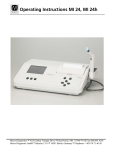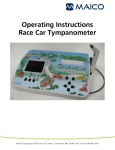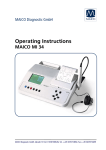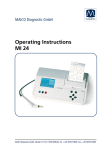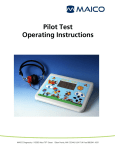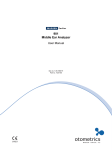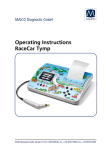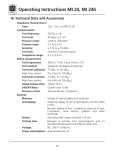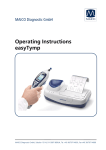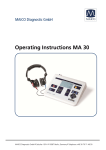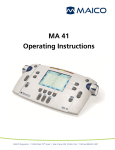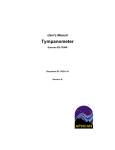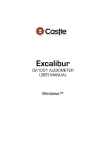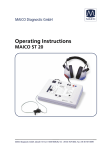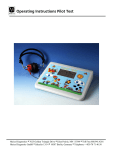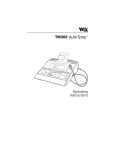Download MI 34, MI 34h Operating Instructions
Transcript
MI 34, MI 34h Operating Instructions MAICO Diagnostics | 10393 West 70th Street | Eden Prairie, MN 55344, USA | Toll Free 888.941.4201 Operating Instructions MI 34, MI 34h Table of Contents Page 1. Introduction 1 2. Description 2 3. Getting started 4 4. How to create a Tympanogram 12 5. How to create a Tympanogram with high probe tone (MI 34h) 17 6. How to measure the Stapedius reflex 18 7. Reflex decay test operation 23 8. Eustachian tube test operation 25 9. Interpreting test results 27 10. How to test children 30 11. Additional Reading 31 12. Individual setup of the MI 34 32 13. Care and maintenance of the instrument 39 14. How to change the printer paper 40 15. Warranty, maintenance and after-sales service 41 16. Safety regulations 44 17. Subjective checklist 45 18. Technical data 46 i Operating Instructions MI 34, MI 34h 1 Introduction Thank you very much for purchasing a quality product from the MAICO family. This automatic Tympanometer MI 34 is manufactured to meet all quality and safety requirements. This user manual should make it as easy as possible for you to become familiar with the functions of the MI 34. The description of the position (e.g., 5 ) of controls, displays and connections, found again in the text, will make it easier for you to learn how to operate the MI 34. If you have problems or have ideas for further improvements, please get in touch with us. Simply call. Your MAICO team 1 Operating Instructions MI 34, MI 34h 2 Description The MI 34 is an automatic instrument that is designed for tympanometric testing. Tests performed in the tympanometric testing mode measure middle ear mobility, ipsilateral acoustic reflex, contralateral reflex, reflex decay and Eustachian tube testing. Test results are displayed on the front panel LCD (liquid crystal display) screen and may be printed. The design of the MI 34 allows rapid and reliable measurements. This equipment is designed for middle ear function screening. PC-Interface: A USB interface for data transfer to a connected computer is built in. 2.1 Tympanometry musculus stapedius Tympanometry is the objective measurement of middle ear mobility (compliance) and pressure within the middle ear system. During the test, a low-pitched probe tone (226 Hz) is presented to the ear canal by means of the hand-held probe. This tone is used to measure the change in compliance in the middle ear system while the air pressure is varied automatically from a positive value (+200 daPa) to a negative value (-400 daPa max.). hearing nerve middle ear bones ear canal ear drum cochlea middle ear eustachian tube Figure 1 The middle ear Maximum compliance of the middle ear system occurs when the pressure in the middle ear cavity is equal to the pressure in the external auditory canal. This is the highest peak of the curve as it is recorded on the chart. The position of the peak on the horizontal axis and on the vertical axis of the chart will provide diagnostic information regarding the function of the middle ear system. Examples of normal and abnormal tympanograms can be found in a later section of this manual. Gradient calculations are reported as the tympanogram width at half of peak compliance expressed in daPa. A “limits” box is available on both the display and printout to aid in diagnosis. Compliance is measured with respect to an equivalent volume of air, with the scientific quantity milliliter (ml). Air pressure is measured in deca-Pascals (daPa). NOTE: 1.02 mm H2O = 1.0 daPa. 2 Operating Instructions MI 34, MI 34h 2.2 Acoustic reflex An acoustic reflex, or contraction of the Stapedial muscle, occurs under normal conditions when a sufficiently intense sound is presented to the auditory pathway. This contraction of the muscle causes a stiffening of the ossicular chain which changes the compliance of the middle ear system. As in tympanometry, a probe tone is used to measure this change in compliance. When the stimulus presentation and measurement are made in the same ear by means of the probe, this acoustical reflex is referred to as an ipsilateral acoustic reflex. When the stimulus presentation and measurement are made in opposite ears, the reflex is referred to as a contralateral acoustic reflex. For best results, this reflex measurement is automatically conducted at the air pressure value where the compliance peak occurred during the tympanometric test. Stimulus tones of varying intensities at 500, 1000, 2000 or 4000 Hz are presented as short bursts. If a change in compliance greater than the selected level is detected, a reflex is considered present. Because this is an extremely small compliance change, any movement of the probe during the test may produce an artifact (false response). The test result is recorded as Pass/No response, and in graphical form. If the tympanometric results display any abnormal findings, the results of the acoustic reflex testing may be inconclusive and should be interpreted with care. Theoretically, a compliance peak is necessary to observe a reflex at peak pressure. 3 Operating Instructions MI 34, MI 34h 3 Getting started Your MI 34 was carefully inspected and packed for shipping. However, it is good practice to thoroughly inspect the outside of the shipping container for signs of damage. If any damage is noted, please notify the carrier immediately. 3.1 Unpacking Remove the accessories. Carefully remove the instrument from the shipping carton. Remove the instrument from the plastic bag and inspect the case for any damage. Notify the carrier immediately if any mechanical damage is noted. This will assure that a proper claim is made. Save all packing material so the claim adjuster can inspect it as well. When the adjuster has completed the inspection, notify the MAICO Special Instrument Distributor you purchased this unit from. Save all the original packing material and the shipping container so the instrument can be properly packaged if it needs to be returned for service or calibration. 3.1.1 Accessories supplied Please check that all accessories listed below are received in good condition. If any accessories are missing or damaged, immediately notify your MAICO Special Instrument Distributor. Description Hand-held probe 24-count eartips kit: (4) yellow, 7 mm (4) green, 9 mm (4) white, 11 mm (4) yellow, 13 mm (4) green, 15 mm (4) blue, 18 mm Thermal printer paper Calibration test cavity Shoulder strap Insert phone or TDH39 contra phone Operating Instructions Part No. 570G-14 6613 6643 6644 6645 6646 6647 6648 5529 5533 58621 4796 4682 1162-0324 4 Operating Instructions MI 34, MI 34h 3.2 Environmental conditions for the MI 34 The MI 34 should be operated in a quiet room. The test room must be at normal temperature, usually 15° C / 59° F to 35° C / 95° F, and the instrument should be switched on about 10 minutes before the first measurement to guarantee precise measuring results. If the device has been cooled down (e.g. during transport), please wait until it has warmed up to room temperature 3.3 Preparing the MI 34 for use 3.3.1 Connect probe and accessories - Connect the probe cable to socket C on the rear of the instrument. - Insert the plug into the socket and secure the connection by fastening the two screws of the connector. - Insert the pressure tube into the socket socket. - Put the enclosed power cable into the power connection socket A and then plug it into a power outlet. The instrument is now operational. 5 B and press it until it is secure on the Operating Instructions MI 34, MI 34h 3.4 Getting familiar with the MI 34 3.4.1 The MI 34 front panel controls 13 1 2 3 4 5 6 7 8 9 10 11 12 Figure 2 MI 34 front panel See the following keys: 1. Print = Printout 3. Reflex = Reflex measure off/ipsi/contra 5. Decay = Decay test key 7. Menu 9. Left = Left (cursor control) 11. Right = Right (cursor control) 13. Power = Power switch 2. L/R = Switch over left/right ear 4. Tymp = Tympanometer test key 6. ETF = Eustachian tube function test key 8. Up = Up (cursor control) 10. Down = Down (cursor control) 12. Enter = Enter How to use the extended functions is described in chapter 9: “Individual Setup of the MI 34." 6 Operating Instructions MI 34, MI 34h 3.4.2 The MI 34 rear panel connections B E C D A Figure 4 Connectors on the rear of the MI 34 A. Power connection socket B. Probe tube connection C. Probe connection socket D. USB PC interface E. Contra receiver socket 3.4.3 Switch the instrument on Turn the power switch 13 on. The LCD will show the type of instrument and software version for a moment. Then the basic measuring figure appears. The MI 34 should be switched on about 10 minutes before the first measurement to guarantee precise measuring results. If the device has been cooled down (e.g. during transport), please wait until it has warmed up to room temperature. 7 Operating Instructions MI 34, MI 34h 3.4.4 The display of the MI 34 The test result is shown during the measurement on the LCD. The measurements are saved automatically and can be printed out in a fast and quiet way with the integrated printer. In (Figure 4) the initial empty measurement screen is shown. The measurement screen shows actual settings, test results and the graphical display of the tympanogram and reflexes. Impedance 3 Right Ipsi Status READY ml Ear Volume 2 Compliance 1 Pressure 0 -600 -300 1 2 80 500 Hz I Gradient 300 daPa 3 80 1000 Hz I AUTO 4 80 2000 Hz I dB 80 4000 Hz I From left to right the top line shows the type of test (impedance is shown in Figure 4), the selected test ear (left or right) and the selected reflex test (ipsi, contra or tympanogram if no reflex test is selected). At the left center, the graph of the tympanogram is shown. At the right, five boxes show the status and test values. Figure 4 The measurement screen of the MI 34 The upper box shows the actual status of the instrument: Ready - means that the instrument is ready for testing In Ear - shows that the probe is inserted in the ear Testing - means that the test is in progress Blocked - means that probe is blocked in the ear Leaking - indicates that the eartip does not have a proper seal The boxes below Status show the volume of the ear canal, the compliance, the pressure at maximum compliance and the gradient of the tympanogram when the test has been completed. The four boxes at the bottom of the screen, marked 1 to 4, show the graphical reflex curves after the test. Below each box the test level (Figure 4: 80 dB), and the test frequencies (Figure 4: 500 Hz, 1000 Hz, 2000 Hz and 4000 Hz) are displayed. After the frequency an “I” shows that ipsilateral testing is selected. Finally, at the very bottom in figure 4 the word Auto and 80 dB scale is shown. This means that the reflex test level will increase automatically until a reflex is found or the maximum level is reached. With the arrow keys, the test levels can be changed to a fixed level. The dB values below the boxes change accordingly. It is possible to have fixed levels from 70 dB to 100 dB or Auto. 8 Operating Instructions MI 34, MI 34h 3.5 Calibrate the probe Adjust the impedance measuring instrument every day to the actual atmospheric pressure by means of the enclosed calibration volume. The calibration is very easy and takes only 20 seconds. Press the menu key 7 and the main menu (Figure 5) appears on the LCD. Select the menu option Calibration with the arrow keys and press Enter. Follow the instructions on the LCD as shown in (Figure 6). Put the probe tip S without eartip into the hole of the test cavity labeled 0.5 ml. The text on the display will request that the probe tip be inserted for the 2 ml calibration. Put the probe tip in the 2 ml cavity. Do this again for the 5 ml volume. The MI 34 will automatically change into the tympanometry mode. The basic menu for the impedance measurement appears again and you are ready for measurements. If the error information Cavity Calibration Out of Range appears during the calibration, please check if the opening of the probe tip is clean and try to recalibrate the probe. If the error information appears again, the probe or the instrument are probably in need ot service. Contact your Maico Special Instruments distributor to get immediate help. 9 Main Menu Tympanometry : Calibration : Setup : Change item ENTER Select item Figure 5 The MI 34 main menu Calibration Place the probe in the .5 ml cavity. Figure 6 The calibration screen Operating Instructions MI 34, MI 34h 3.6 Getting familiar with the probe The probe of the MI 34 is shown in (Figure 7). The probe head is adjustable to three angles (0°, 60° and 80°). It is adjusted by turning the locking screw R at the bottom of the probe using a coin or a screw driver. Adjust the probe head P by pulling it into the required position until it rests. After it is set to the required position tighten the fixation screw again. The probe button M can be used to select the M B O D EL C N EP Q E required test ear, or pulse function. The color of the O control light changes accordingly to red (right ear) or blue (left ear). The color of the control light on the probe indicates D R EL C N EP your current operation. Figure 7 A red control light The probe of the MI 34 indicates that the right ear is selected. The system is ready for measurements. As soon as you have put the probe into the auditory canal the control light turns green. Now the test is in progress. Do not change the position of the probe until the green control light goes out indicating the end of the measurement. A blue control light indicates that the left ear is selected. The system is ready for measurements. As soon as you have put the probe into the auditory canal the control light turns green. Now the test is in progress. Do not change the position of the probe until the green control light goes out indicating the end of the measurement. A yellow control light indicates an error. The kind of the error is indicated on the LCD under status: Leaking: The eartip is not sealed in the auditory canal. Change the position of the probe until the control light turns green. If you are not successful use a bigger eartip. Blocked: Indicates blockage in the probe opening. Change the position of the probe so that it points straight into the auditory canal until the control light turns green. If you are not successful, check that the probe is not blocked with ear wax. 10 Operating Instructions MI 34, MI 34h The complete probe insert can be changed by pressing the release button Q . 3.7 Choose an appropriate eartip Choose an eartip of the appropriate size from the eartip set. Put the eartip tightly on the probe tip. The probe tip should end near the end of the eartip. It should not be inserted more than about 1 mm inside the eartip or protrude out of the eartip (see Figure 8). By choosing an appropriate eartip and placing it correctly on the probe you create the basic conditions for measurements without problems and mistakes. Now all preparations are concluded and you can start the impedance and reflex measurement. Please read the following chapters. min 0 mm max 1 mm Figure 8 Proper placement of eartip 11 Operating Instructions MI 34, MI 34h 4 How to create a Tympanogram In the following paragraph we will briefly explain the principle and the background of the impedance measurement to create a better understanding. If you want to begin the measurements immediately, just skip this paragraph and continue reading section 4.3 “Preparing the Measurements.” 4.1 The basics of the impedance measurement The impedance measurement assists in diagnosing of the condition of the middle ear and can therefore not be compared directly with other audiometric tests such as sound or speech audiometry which assists in the measurement of hearing. Furthermore the impedance measurement is an objective measuring method which does not depend on the cooperation of the test person and can therefore not be falsified by the patient. The two most important impedance measuring methods possible with your MI 34 are tympanometry and the measurement of the Stapedius reflex which is discussed in chapter 5: “How to measure the Stapedius reflex.” musculus stapedius hearing nerve middle ear bones ear canal ear drum cochlea middle ear eustachian tube Figure 9 The middle ear Figure 10 Principle of the impedance measurement 12 Operating Instructions MI 34, MI 34h The impedance measurement examines the acoustic resistance of the middle ear. If the eardrum is hit by a sound, part of the sound is absorbed and sent via middle ear to the inner ear while the other part of the sound is reflected. The stiffer the eardrum is the more sound is reflected and the less sound reaches the inner ear. Inside the probe of the impedance measuring instrument a small loudspeaker is installed which emits a low frequency sound through a tube (Figure 10: A) into the auditory canal before the eardrum. Another tube (Figure 10: B) is connected to the microphone inside the probe which receives the sound. Together with a third tube (Figure 10: C), all three are inserted nearly to the eardrum and are made airtight against outside pressure by the eartip. A manometer and a pump, which can produce both positive and negative pressure, are connected with tube C. Less sound is reflected to the microphone when the eardrum is stiff and the eardrum transmits the majority of the sound via the middle ear to the inner ear. The highest compliance is normally reached with an air pressure corresponding to the outside pressure. 2,0 1,6 Compliance ( ml) When performing tympanometry during a measurement, a continuous change of positive and negative pressure is produced by the pump of the instrument in the outer auditory canal. The compliance is measured simultaneously and shown in a diagram (the tympanogram) which illustrates the compliance in ml over the pressure in daPa. In (Figure 11), the area for normal tympanogram curves is hatched. Here you can see that the highest compliance is reached with normal pressure. When you create positive and negative pressure the eardrum stiffens - the compliance decreases. 2.0 1,2 0,8 1.6 0,4 0 1.2 -300 -200 -100 0 +100 Pressure ( daPa ) 0.8 0.4 0 Figure 11 Tympanogram (normal curve area is hatched) You can draw conclusions on the condition of the middle ear from the form and the values of the tympanogram. 13 Operating Instructions MI 34, MI 34h 4.2 Preparing the patient Explain to the patient that the measurement is painless and that nothing enters the auditory canal. The patient does not have to respond when there are loud test sounds or when the pressure in the auditory canal changes. In no case should the patient swallow, chew or move during the measurement. 4.3 Preparing the measurement The LCD shows the empty measurement screen for the right ear and the control light of the probe turns red. To measure the left ear, change the side by pressing the L/R key or the probe button M . Then the selected test ear shown in the middle-top of the LCD will change from RIGHT to LEFT and the control light of the probe will turn blue. Switch off the reflex measurement by pressing the Reflex key 3 . The word Tympanometer must appear at the right top of the display. Make sure the auditory canal is clear. Choose an eartip according to the size of the auditory canal and put it firmly onto the probe tip (see Figure 8 in chapter 3.7). 4.4 Measuring the tympanogram Take hold of the top of the outer ear and pull it back. Insert the probe with the eartip into the auditory canal until the control light of the probe is green indicating the start of the test. Do not move the probe until the green light goes out; the patient must not swallow or speak during the measurement. During the test the LCD will display the tympanogram on the left side while the test is running and the values will appear on the right side. After about 4-5 seconds the test is completed Figure 12 and the green light turns off. Measurement screen (only tympanogram) Now you can remove the probe from the ear. Impedance 3 Right Tympanometer Status READY ml Ear Volume 2 Compliance 1 Pressure 0 -600 -300 300 daPa Gradient Scale If an error occurs during the measurement the test will stop. If leakage occurs, the control light of the probe turns yellow and Leaking will appear under Status. If the probe is blocked, the control light of the probe turns yellow and Blocked will appear under Status. Please proceed as described in chapter 3.6 “Getting familiar with the probe.” To measure the other ear, change the side by pressing the L/R key or the probe buttonand repeat the measuring procedure described above. 14 Operating Instructions MI 34, MI 34h 4.5 How to evaluate the tympanogram display After having completed a measurement you can see the results on the LCD. Impedance 3 Right Tympanometer Status READY ml Ear Volume 0.94 ml 2 Compliance 0.81 ml 1 Pressure - 37 daPa 0 -600 -300 300 daPa Gradient 32 daPa Scale On the left side of the display you see a graph of the tympanogram. The area surrounded by the box is valid for “normal” tympanograms. You can change the area or turn it off. For details see chapter 11 “Individual Setup of the MI 34.” Figure 13 Display of a normal tympanogram In the top-middle of the LCD, the words Right or Left indicate the ear chosen at the moment. Tympanometer (at the top right) - indicates that the reflex measurement has been switched off. In the boxes to the right the following test measurements are displayed: Ear Volume - indicates the volume of the section of the auditory canal between the eartip and the eardrum in ml (in the example 0.94 ml). Compliance - indicates the maximum value of the compliance from the tympanogram in ml (in the example 0.81 ml). Pressure - indicates the pressure with the highest measured compliance (in the example -37 daPa). Gradient - calculations are reported as the tympanogram width at half of peak compliance expressed in daPa (in the example 32 daPa). 15 Operating Instructions MI 34, MI 34h 4.6 How to print the test result After the end of a test you can print the results for your records by pressing the Print button 1 . The quiet thermal printer prints out the example used in the previous paragraph in only six seconds. While the printer is working, no key action is possible and the probe is inactive. Figure 14 shows the printout. Id No: Patient’s Id number. Date: Actual test date. Name: Name of the patient. MAICO MI 24 Id No.: Tympanogram Right 3 ml 2 0.94 ml 1 0.81 ml - 37 daPa 0 -600 Examiner: Name of the examiner. Date: Name: Examiner: Remarks: -300 Ear Volume Compliance Pressure Gradient 300 daPa 32 daPa 0.94 ml 0.81 ml -37 daPa 31 daPa Remarks: Additional information about the test or patient. All other values and the tympanogram correspond to those you have seen on the LCD (explained on the previous page under 4.5). The “intelligent” printer control helps you save paper. It will only print out what was actually measured. The printout in the example above does not show reflex frequencies because only the tympanogram was measured. If you have saved two tympanograms (for example, both the left and the right ear) they are printed side by side. Figure 14 Printout of a normal tympanogram You can produce as many printouts as you want by pressing the Print button several times. 4.7 How to delete the test results By holding down the R/L key for at least two seconds and the measurement memory will be deleted. On the LCD the message Delete all Data? appears. Press Enter to delete all patient data. Then the LCD shows an empty measurement screen. If you press the Menu button, you return to the measurement screen without deleting the measurement data. 16 Operating Instructions MI 34, MI 34h 5 How to create a tympanogram with high probe tone In addition to the standard 226 Hz probe tone tympanometry, the MI 34h has a 1 kHz frequency probe tone. A tympanogram recorded using the high probe tone is generally better suited for screening newborns and provides more accurate results for those subjects. 5.1 To select high probe tone frequency When the instrument is switched on, it automatically powers-up in the standard tympanometry mode. In order to choose tympanometry with high probe tone, hold down the Reflex key for two seconds. The probe must not be in the ear. The screen for high probe tone tympanometry looks very similar to the normal tympanometry mode, however the following differences will appear on the screen: The scaling is now measured in mmho The pre-selected frequency (1000 Hz) is displayed in the upper left hand side of the screen The tympanometry test with high probe tones is performed in the exact same way as a normal tympanometry test. It is possible to perform normal tympanometry and high probe tone tympanometry in one test session and print the results for comparison. When the first tympanometry curve has been drawn, press the Reflex key for two seconds to switch to high probe tone tympanometry. Now the next curve will be drawn automatically. Press Print and a printout presenting both curves will appear. Note: It is not possible to perform reflexes on the basis of a high probe tone tympanogram. 17 Operating Instructions MI 34, MI 34h 6 How to measure the Stapedius reflex 6.1 The basics of the Stapedius reflex measurement While tympanometry measures the change of the compliance caused by changing pressure in the outer auditory canal, the Stapedius reflex measurement works with a changing compliance caused by contraction of the Stapedius muscle in the middle ear. The contraction called Stapedius reflex - causes a decrease in compliance and is caused by loud acoustic stimuli. Regardless whether the acoustic Figure 15 stimulus is active on the left or on The middle ear the right or on both sides the Stapedius reflex is always binaural, i.e. it occurs in both ears at the same time. The Stapedius reflex is caused in ears of adults with normal hearing with sound pressure levels between 70 and 105 dB. musculus stapedius hearing nerve middle ear bones ear canal ear drum cochlea middle ear eustachian tube In the probe ear, the reflex method continuously measures the compliance with the pressure which was caused before the highest compliance measurement. Simultaneously the stimulus ear is irritated by the sound which causes the contraction of the Stapedius muscle. The ipsilateral reflex measurement uses the same ear for the probe and the stimulus. Figure 16 Ipsilateral test The contra-lateral measurement uses different ears for the probe and the stimulus. The acoustic stimulus is applied to the ear opposite the probe ear. If the applied stimulus causes a reflex, the impedance measuring instrument registers a decrease in compliance in the “probe ear” which indicates a Stapedius reflex at the actual test frequency and the test level. The test level which was set when the reflex occurred is called reflex threshold and is shown in dBHL (dB hearing level). 18 Figure 17 Contralateral test Operating Instructions MI 34, MI 34h 6.2 Preparing the patient In addition to the general introduction described in chapter 4.2, explain to the patient that loud test sounds will occur during the reflex measurement. It is very important that the patient does not move because a reflex can be registered with a change of compliance of 0.03, 0.05 or 0.08 ml depending on the setting of the Reflex Sensitivity in the Reflex Setup Menu. 6.3 Preparing the ipsilateral measurement The LCD shows the empty tympanogram for the right ear and the control light of the probe is red. Impedance 3 To measure the left ear, change the side by pressing the L/R key or the probe button. The selected test ear shown in the middle-top of the LCD will change from Right to Left and the control light of the probe will turn blue. Right Ipsi Status READY ml Ear Volume 2 Compliance 1 Pressure 0 -600 -300 1 2 80 500 Hz I Gradient 300 daPa 3 80 1000 Hz I AUTO 4 80 2000 Hz I dB Turn the reflex measurement on by pressing the Reflex key. The word Ipsi must appear at the right top of the display. The sound stimuli for the reflex measurement are reproduced by the receiver integrated in the probe. 80 4000 Hz I Figure 18 Display tympanogram and reflex (ready for measurement) Set the desired intensity level with the down/up keys. On the LCD below the reflex boxes at the bottom, the selected level in dB (figure 18: 80 dB) appears. The I indicates that an ipsilateral test is selected. You can choose between the fixed levels 70, 75, 80, 85, 90, 95 and 100 dBHL and Auto with a starting level of 70 or 80 dBHL. If you choose Auto, the MI 34 starts with the preset level and increases the level automatically until a reflex is registered or the maximum value is reached. You can choose your individual starting level and maximum level. If you have chosen a fixed level, the instrument measures only with this level. Make sure the auditory canal is clear. Choose the correct eartip according to the size of the auditory canal and put it firmly onto the probe tip (see chapter 3.7 figure 8). 19 Operating Instructions MI 34, MI 34h 6.4 Taking the ipsilateral measurement Carry out the measurement as described in chapter 4.4 “Recording the Tympanogram.” The Stapedius reflex is measured after the measurement of the tympanogram. During the measurement of the Stapedius reflex the change of the compliance is represented in real time on the LCD. When the test is finished the curves for the changes of compliance at 500 Hz, 1000 Hz, 2000 Hz and 4000 Hz are shown in four separate graphs at the bottom of the measurement screen (see Figure 19). Below each curve is the Figure 19 test level where a Stapedius reflex Example of a normal tympanogram was registered automatically. This is with ipsilateral reflex results indicated by a Pass below the frequency. If no reflex was detected, a Fail is reported and the maximum level is shown. Impedance 3 Right Ipsi Status READY ml Ear Volume 0.94 ml 2 Compliance 0.81 ml 1 Pressure - 37 daPa 0 -600 -300 1 300 daPa 2 100 500 Hz I PASS 3 100 1000 Hz I PASS AUTO Gradient 32 daPa 4 100 2000 Hz I PASS Scale dB 95 4000 Hz I PASS You can judge this by watching the real time graph if you have a real Stapedius reflex or only disturbance and artifacts. The lower dotted zero-line of a graph indicates the measured compliance without a test sound. All the positive or negative changes of compliance are shown as deviation from the zero-line. If a Stapedius reflex occurs, the compliance increases and the curve rises. The box which appears during the test symbolizes the threshold at which the MI 34 accepts a change of compliance as a valid Stapedius reflex. 20 Operating Instructions MI 34, MI 34h 6.5 Preparing the contralateral measurement Switch on the contralateral reflex measurement by pressing the Reflex key (the word Contra must appear on the right top of the LCD). Here the highest fixed level is 120 dBHL (with TDH 39 contra phone only). Impedance 3 Right Contra Status READY ml Ear Volume 0.94 ml 2 Compliance 0.81 ml 1 Pressure - 37 daPa 0 -600 -300 1 100 500 Hz C PASS Gradient 32 daPa 300 daPa 2 3 100 1000 Hz C PASS AUTO 4 100 2000 Hz C PASS Scale dB 95 4000 Hz C PASS The contralateral measurement produces more reliable results because the receiver emitting the test signal and the probe measuring the compliance are separated. If you are using an insert phone for contralateral measurement, put an appropriate eartip on the insert phone and insert it in the contralateral ear. Continue now as described previously for the ipsilateral measurement. Figure 20 Example of a normal tympanogram with contralateral reflex results 6.6 How to interpret the reflex display After having carried out a measurement you can read the recorded values on the LCD. In addition to the tympanogram shown on the left side and the values shown on the right, the results of the reflex measurement appear in the lower part of the display. In the four boxes marked 1 to 4 the Stapedius response is shown graphically. Below each box the test level, the test frequency and the type of the test (I=ipsi, C=contralateral) are shown. The test result is also shown as Pass or Fail. In (Figure 21), for 500 Hz a Stapedius reflex was registered at 100 dBHL and for 4 kHz at 95 dBHL. If no reflex threshold is registered, Fail appears below the frequency. Impedance 3 Right Ipsi Status READY ml 2 Ear Volume 0.94 ml 1 Compliance 0.81 ml 0 Pressure - 37 daPa -600 -300 1 300 daPa 2 100 500 Hz I PASS 3 100 1000 Hz I PASS AUTO Gradient 32 daPa 4 100 2000 Hz I PASS Scale dB 95 4000 Hz I PASS Figure 21 Example of a normal tympanogram with ipsilateral reflex results Correct interpretation of the reflex results should be made in conjunction with the tympanogram, the graphic reflex display and other audiometric data. 21 Operating Instructions MI 34, MI 34h How to print the test results After a test, print the results for your documents by pressing the Print button. The printer prints out the example used in the previous paragraph in only 12 seconds. MAICO MI 24 Id No.: Tympanogram Right 3 ml 2 0.94 ml 1 0.81 ml - 37 daPa 0 -600 -300 300 daPa Ear Volume Compliance Pressure Gradient ml 0,15 0,10 0,05 0 Reflex Ipsi 500 Hz PASS s dBHL 100 0,15 0,10 0,05 0 Ipsi 1000 Hz PASS s dBHL 100 ml 0,15 0,10 0,05 0 Ipsi 2000 Hz PASS s dBHL 100 ml 0,15 0,10 0,05 0 32 daPa 0.94 ml 0.81 ml -37 daPa 31 daPa Right ml While the printer is working no key action is possible and the probe is inactive. Date: Name: Examiner: Remarks: Ipsi 4000 Hz PASS s 95 dBHL In addition to printing the text as seen in chapter 4.6 the result of the reflex test is printed out. The level value (dBHL) at which a reflex had been measured appears below the graph. If no reflex was registered, NR for no response is printed on the top of the graph behind the test frequency. Figure 22 Printout of a normal tympanogram with ipsilateral reflex measurement 22 Operating Instructions MI 34, MI 34h 7 Reflex decay test operation The diagnostic probe insert must be used for this test. If you are currently using the screening probe insert, do not use it for this test! - To exchange the probe insert press the release button of the probe with a tool or a pen. Remove the screening probe insert. - Put the diagnostic probe insert into the probe head. Please recognize the correct position of the connector of the diagnostic probe insert. Press the diagnostic probe insert into the probe head until it fastens. - Place the shoulder strap firmly over the patient’s shoulder. Slip the probe into the holder of the shoulder strap (as shown in Figure 24). Make sure you can see the LEDs of the probe. Place an appropriately sized eartip firmly on the probe tip. Insert the tip into the ear canal, enough to make a seal and provide support for the probe tip. - If you are performing a contralateral test apply an appropriate ear plug on the insert phone and insert it in the contralateral ear. - If you’re using the headset contra phone, place the phone over the opposite ear, making sure the receiver lines up directly with the ear canal. Figure 23 The diagnostic probe insert Figure 24 Fixation of the diagnostic probe 23 Operating Instructions MI 34, MI 34h - Run a tympanogram and reflex test as described previously. - Highlight Reflex Decay on the main menu or press the Decay key to advance to the reflex decay test. - Select a frequency test level. - The test level should be set 10 dB above the reflex threshold measured before. - Set the desired sound level with the down key or the up key➋ respectively. On the LCD below the left reflex box at the bottom the selected level in dB appears. The starting level is always 80 dB. - If you would like to change the test frequency from the default 1 kHz use the left key or the right key respectively. On the LCD below the reflex boxes at the bottom below the selected level in dB, the test frequency appears. - The pressure will automatically be set at the peak pressure for maximum compliance. - Instruct the patient not to talk, swallow, yawn or move until the test is over. Any movement or sound will give unreliable results. - Press the left key when ready to run the test. - Watch the probe LEDs for an indication of test operation. See chapter 3.6 for an explanation of the LEDs. - An individual whose peak amplitude decays 50% within the 10 second time limit shows signs of adaptation, or decay. The percentage value is displayed after 10 seconds. - To store a test for printout, press the Decay key. On the LCD in the left reflex box at the bottom the last result is now shown. - The next test box is now highlighted. You can now perform a test with a different level or frequency. Select it as described previously. - When you have finished all decay tests you can print the results for your documents by pressing the Print key. 24 Operating Instructions MI 34, MI 34h 8 Eustachian tube test operation The diagnostic probe must be used for this test. If you have an additional impedance screening probe, do not use it for this test! 8.1 - If you have not already done so, press the Menu button, highlight Calibration and calibrate the diagnostic probe (as described in chapter 3.5). - The Eustachian tube test can be used in patients with normal TM or in patients who have a perforated TM or PT tubes in place. ETF test for patients with normal TM - Highlight ETF Intact from the main menu and press the left key or the ETF key to advance to the Eustachian Tube Function screen. It is not necessary to run a tympanogram before running this test. - ETF Intact appears at the upper right corner of the LCD. - Connect the probe as described in chapter 6 (Reflex decay test). Place an appropriately sized eartip firmly on the probe tip. Insert the tip into the ear canal, well enough to make a seal and provide support for the probe tip. - Instruct the patient not to move or talk until the test is over, as any sound or movement will give unreliable results. - Press the left key when ready to begin the test. - The pressure value at the maximum compliance appears under Pressure 1. - Make the patient decrease middle ear pressure by swallowing will appear on the LCD. - Press the left key when ready to begin the second test. - The pressure value at the maximum compliance with decreased middle ear pressure appears under Pressure 2. - Make the patient increase middle ear pressure by the Valsalva Maneuver. Appears on the LCD. - Press the left key when ready to begin the second test. - The pressure value at the maximum compliance with increased middle ear pressure is shown under Pressure 3. - After a test you can print the results for your documents by pressing the Print key. 25 Operating Instructions MI 34, MI 34h 8.2 ETF test for patients with perforated TM - The test determines if the patient can open his/her Eustachian tube in the presence of positive pressure delivered by the probe to the external ear canal. The amount of positive pressure is predetermined and can be set as high as +300 daPa. While pressure is being applied the patient is instructed to swallow. If the Eustachian tube opens, a drop in pressure is recorded. A positive test result will show a stair step effect or a complete drop to 0 daPa as the Eustachian tube opens. The graph displays the vertical axis as pressure, and the horizontal axis as time. - Highlight ETF Perforated from the main menu and press the left key or the ETF key to advance to the Eustachian Tube Function screen. It is not necessary to run a tympanogram before running this test. - Press the ETF key again and ETF perforated appears at the upper right corner of the LCD. - Set the maximum pressure using the Up key or Down key. - Connect the probe as described in chapter 6 (Reflex decay test). Place an appropriately sized eartip firmly on the probe tip. Insert the tip into the ear canal, well enough to make a seal and provide support for the probe tip. - Instruct the patient not to move or talk until the test is over, as any sound or movement will give unreliable results. - Press the left key when ready to begin the test. Pressure will increase to the predetermined setting. - Let the pressure run a few seconds at peak pressure to verify a successful seal. - Once the peak pressure has been obtained ask the patient to swallow. - If the Eustachian tube opens, a drop in pressure will be recorded. - Repeated attempts to swallow will display a stair step effect, or a complete drop to 0 daPa. - The test will stop after the allotted 50 seconds have elapsed. - After a test you can print the results for your documents by pressing the Print key. 26 Operating Instructions MI 34, MI 34h 9 Interpreting Test Results 9.1 Understanding the printout The printout contains the following information: Ear volume, Compliance, Pressure, Gradient, Reflex Test Results (Pass, NR) and ipsi, contra or tympanogram (depending on the test you have performed). MAICO MI 24 Id No.: Date: Name: Examiner: Remarks: Tympanogram Right 3 ml 2 0.94 ml 1 0.81 ml - 37 daPa 0 -600 -300 300 daPa Ear Volume Compliance Pressure Gradient Reflex Right ml 0,15 0,10 0,05 0 Ipsi 500 Hz PASS s dBHL 100 ml 0,15 0,10 0,05 0 Ipsi 1000 Hz PASS s dBHL 100 ml This information provides the data you need to interpret the test results. 0,15 0,10 0,05 0 Ipsi 2000 Hz PASS s dBHL 100 ml 0,15 0,10 0,05 0 32 daPa 0.94 ml 0.81 ml -37 daPa 31 daPa Ipsi 4000 Hz PASS s 95 dBHL A graph of the tympanogram is provided (Figure 25) to assist you in a visual interpretation of the test. This graph is a representation of the relative mobility of the middle ear system. The horizontal axis shows the changes in air pressure and the resulting mobility of the system. The compliance is recorded on the vertical axis. This mobility is expressed as a change in the volume of the ear canal in ml. The reflex is shown in up to four graph with time on the horizontal axis and the change of the compliance on the vertical axis. Figure 25 Printout of a normal tympanogram 27 Operating Instructions MI 34, MI 34h 9.2 Interpreting the tympanometric test result As a general rule, values for ear canal volume should be between 0.2 and 2.0 ml (children and adults). A variance will be seen within this range depending on the age and ear structure of the person. For example, a 2.0 ml or larger reading in a small child could indicate a perforation in the tympanic membrane, while it may be a normal reading in an adult. You will become more familiar with the normal ranges when you use the instrument. The normal range for compliance is 0.2 ml to approximately 1.8 ml. A compliance peak within the range indicates normal mobility of the middle ear system. A peak found outside of these limits may indicate one of several pathologies. Middle ear pressure should be equivalent to ambient air pressure (0 daPa on an air pressure scale). Minor shifts of the peak compliance to the negative may occur with congestion and are rarely to the positive side. Establish criteria for abnormal negative pressure when you become more familiar with using the equipment. It is generally accepted that negative pressure of greater than -150 daPa indicates a referral for medical evaluation. A normal tympanogram is shown on the previous page in figure 23. 9.3 Abnormal Values It is the purpose of this section to provide samples of tympanograms which reflect abnormal states of the middle ear mechanism. It is not the intention of this section to provide you with a complete guide to interpreting results. Complete information regarding pathologies and abnormal impedance testing can be found in the literature referenced. A perforation in the tympanic membrane will cause a high ear canal volume measurement because the instrument will measure the volume of the entire middle ear space. The MI 34 may refuse to run the test, with the probe indicating a volume out of tolerance by illuminating the red light, or a flat tympanogram will be recorded since no movement will occur with a change in air pressure. An extremely flaccid tympanic membrane or an ossicular chain discontinuity will yield a very high peak compliance in the presence of normal middle ear pressure. Ear canal volume will be normal and the reflex will be absent. A fixation of the ossicular chain, as in otosclerosis, will produce a tympanogram with very low compliance in the presence of normal middle ear air pressure. Ear canal volume is normal and the reflex is absent. 28 Operating Instructions MI 34, MI 34h Middle ear fluid such as in serious otitis media will yield a very flat tympanogram with no definite peak and negative air pressure. A resolving case or beginning case may produce a reduced peak in the presence of severe negative middle ear pressure. The ear canal volume is normal and the reflex is either absent or at an elevated level. Eustachian tube dysfunction in the absence of fluid will show a normal compliance curve, but it will be displayed to the negative side of the tympanogram. Ear canal volume will be normal and the reflex may be present, depending on the degree of involvement. 29 Operating Instructions MI 34, MI 34h 10 How to test children When practicing impedance measurement with small children, be aware of problems caused by the child being restless or afraid of the examination or reacting sensitively to the change of pressure and the loud test sound. There are also different conditions of the eardrum and the middle ear which do not appear in ears of adults. It may be difficult to create a probe seal with restless children. If the child yawns or cries, the instrument will not have stable pressure in the outer auditory canal. In addition, speaking causes Stapedius muscle reflexes which lead to a change in the compliance of the eardrum. The child should be made familiar with the surroundings and the ear being touched by the probe in order to carry out a successful impedance measurement. This could be done by getting in touch with the child and by playfully touching the ear with the probe. If you can touch the ear without problems, the child will normally accept the probe being inserted. 30 Operating Instructions MI 34, MI 34h 11 Additional Reading Auditory Disorders: A Manual for Clinical Evaluation Jerger, Susan, and James Jerger Boston: College Hill Press, 1981 Handbook of Clinical Audiology Katz, Jack Baltimore: William & Wilkins, 1994 Roeser´s Audiology Desk Reference Roeser, Ross J. New York / Stuttgart: Thieme, 1996 Auditory Diagnosis Silam, Shlomo and Carol A. Silvermann San Diego / London: Singular Publishing Group, 1997 31 Operating Instructions MI 34, MI 34h 12 Individual Setup of the MI 34 The MI 34 offers many options for the experienced user to adapt the instrument to individual demands. Main Menu The settings shown in the figures are the standard settings. If you have altered a value by accident you just have to return to the standard setting shown here and the instrument will work as before. By pressing the Menu key 4 you can return from every sub-menu to the main menu and tympanometry mode. You can change the menu options with the Up/Down/Left/Light cursor keys. The menu option selected is highlighted on the LCD (Setup in Figure 26). Accept the chosen menu option by pressing Enter. Tympanogram : Reflex Decay : ETF Intact : ETF Perforated : SetupCalibration : Setup : Change item ENTER Select item Figure 26 MI 34 main menu 12.1 The setup menu Select the menu option Setup as illustrated in figure 27 and the main setup menu will appear on the LCD. You can make different settings for the measurement of the tympanogram and the Stapedius reflex as well as the instrument setup (for example the contrast of the LCD). All your settings are saved permanently until you change them again. The settings also remain when the instrument is switched off. 32 Operating Instructions MI 34, MI 34h 12.2 The Tympanometer setup Select the menu option Tympanometer Setup Menu as illustrated in (Figure 27) and the Tympanometer Setup Menu will appear on the LCD. Change the menu options with the Up/Down cursor keys. Change the displayed item with the Left/Right cursor keys. The following settings are possible: Main Setup Menu Pump speed: Tympanometry Setup Menu : With this option you can set the measurement speed. With Automatic, the pump speed adjusts automatically to the test conditions. It is possible to choose Minimum, Medium or Maximum as well. A lower pump speed creates a higher precision of the measurement but needs more test time. Reflex Test Setup Menu : Common Setup Menu : Clinic Setup Menu : Change item ENTER Select item MENU Exit Figure 27 MI 34 setup menu Display limits: On displays normative boundries in the tympanogram screen. Off turns it off. Tympanometry Setup Menu Pump Speed Pump Speed : Automatic : Automatic Display Limits : On Press. Limit hi: Press. Limit Hi : 100 daPa With this option you can set the right limit of the normative box displayed in the tympanogram test screen. Values can be set between 0 daPa and +200 daPa in steps of 25 daPa. Press. Limit Lo : -200 daPa Compl. Limit Hi : 1.5 ml Compl. Limit lo : 0.1 daPa Seal Sensitivity : Medium Change item Change item setting Press. Limit lo: MENU Exit Figure 28 MI 34 Tympanometer Setup Menu (pump speed selected) (display limits setup selected) With this option you can set the left limit of the normative box displayed in the tympanogram test screen. Values can be set between -400 daPa and -25 daPa in steps of 25 daPa. 33 Operating Instructions MI 34, MI 34h Comp. limit hi: With this option you can set the upper limit of the normative box displayed in the tympanogram test screen. Values can be set between 0.1 ml and 3 ml in steps of 0.1 ml. Comp. limit lo: With this option you can set the lower limit of the normative box displayed in the tympanogram test screen. Values can be set between 0.1 ml and 1.0 ml in steps of 0.1 ml. To leave the Tympanometry Setup Menu press the Menu button. Seal sensitivity: Set the sensitivity for detecting a seal to Minimum, Medium or Maximum for starting a test. Minimum sensitivity setting gives you the fastest starting test. Maximum will give you a slower starting test yet it will be more detailed. 34 Operating Instructions MI 34, MI 34h 12.3 The Setup menu for reflex test Select the menu option Reflex Test Setup Menu from the main setup menu as described before for the Tympanometry Setup Menu. The Reflex Test Setup Menu will appear on the LCD. The reflex setup menu offers the following options: Auto start dB : Reflex Test Setup Menu With this option you can choose the starting acoustic pressure level if the automatic identification of the reflex threshold is switched on. You can choose the acoustic pressure levels from 70 dBHL to 120 dBHL in steps of 5 dB. Auto maximum dB: With this option you can choose the maximum acoustic pressure level the MI 34 uses if the automatic identification of the reflex threshold is switched on. You can choose the maximum acoustic pressure levels from 80 dBHL to 120 dBHL in steps of 5 dB. Auto. Start dB : 80 Auto. Maximum dB : 105 Reflex sensitivity : Normal Print graphic : On 500 Hz : On 1000 Hz : On 2000 Hz : On 4000 Hz : On Ipsi AGC : On Change item Change item setting MENU Exit Figure 29 MI 34 Reflex Setup Menu (auto start dB setup selected) Reflex sensitivity: With this option, select the sensitivity of the Stapedius reflex detection. The Sensitive setting will achieve Pass as test results with very small compliance changes. (i.e. 0.03ml) The Normal setting is the default setting. (i.e. 0.05ml) With the Robust setting a larger compliance change is needed to detect a Pass. (i.e. 0.08) Print graphic: With this option the printout of the graphic reflex display can be turned on or off for documentation. 500 Hz : 1000 Hz : 2000 Hz : 4000 Hz : The Stapedius reflex test can be turned on and off with this option. The Stapedius reflex test can be turned on and off with this option. The Stapedius reflex test can be turned on and off with this option. The Stapedius reflex test can be turned on and off with this option. 35 Operating Instructions MI 34, MI 34h Ipsi AGC: With this option you can switch the automatic gain control (AGC) of the ipsilateral test level on and off. With the setting on, the reflex test level in the ear is automatically adjusted to the desired test level compensating the effect of different ear canal volumes. With the setting off, the reflex test level in the ear is not adjusted to the individual ear canal volume. To leave the Setup Menu for reflex, press the Menu button. 36 Operating Instructions MI 34, MI 34h 12.4 The Common Setup Menu Select the menu option Common Setup Menu from the main setup menu. The common setup menu offers the following options. Power-up: Choose the test mode of the MI 34 after switching on. With the Tymp setting, only tympanometry is tested after power-up. Common Setup Menu Power-up : Tymp and Reflex Baud Rate : 57600 Remote switch : L/R With Tymp and Reflex, tympanometry and reflex are tested after power-up. Subject Data Printout : On Clinic Data Printout : On Print after Test : Off Baud Rate: Language : English Display adjust : Set the transmission speed of the serial data interface. Possible settings are 57600 Baud or 38400 Baud. Remote Switch: Change the function of the probe button. You can choose between: Change item Change item setting MENU Exit Figure 30 MI 34 Reflex Setup Menu (Auto start dB setup selected) L/R: the test ear can be selected with the probe button. Pause: the test can be paused and restarted with the probe button. L/R or Pause: both the test ear and the test can be selected, paused and restarted with the probe button M . Subject Data Printout : Turn the printout of the headline (data entry area at the top) on or off. Clinic Data Printout : If you entered your clinic data the printout of the entered data can be switched on and off with this option Print after test : With this option you enable an automatic printout after you have finished a test by turning it on. With the setting off, the printout will be processed after you press the Print button. 37 Operating Instructions MI 34, MI 34h Language : You can choose from the following languages: German, French, English or Spanish for the text on the LCD and the printout. After making a selection, all text will appear in the chosen language. Display adjust : The contrast of the LCD can be changed with this option. 12.5 Insert your personal printout data Select the menu Clinic Setup Menu option from the Main Setup Menu, (see Figure 27), to enter all required data for your clinic. The data will be printed out with the test results and the patient data. 38 Operating Instructions MI 34, MI 34h 13 Care and maintenance of the instrument Disconnect the power plug before cleaning. To clean the instrument, probe, contralateral receiver and other accessories use a soft, damp cloth (use warm soapy water; no liquids containing alcohol or ammonia should be used) to gently wipe the area clean. During cleaning, please ensure that no liquid runs into the switches, level control or probe openings. 39 Operating Instructions MI 34, MI 34h 14 How to change the printer paper At the right side of the housing, pull the printer cover up using its finger recess in the front of the printer cover. Remove the printer cover. Remove the empty paper roll. Place the new paper roll in the paper compartment in such a way that the paper unrolls from the bottom side of the roll. Pull the blue lever, which is located on the right front of the printer, forward into position. The paper must feed from the bottom because it is only coated on one side. If it is inserted wrong, no printout will be visible! Gently insert the paper end in between the rubber roll and the black plastic part at the rear of the printer. Feed the printer paper until it appears from the upper part of the rubber roll. Feed about 4 – 5 inches of paper from the roll. Push the blue lever back into its backward position. Guide the paper end through the paper slot of the printer cover. Close the printer cover by putting the two guide rails at the end of the printer cover into their appropriate slots in the paper compartment of the housing of the MI 34. Press the front of the printer cover down until it fastens. You are now ready to print. 40 Operating Instructions MI 34, MI 34h 15 Warranty, maintenance and after-sales service 15.1 Warranty This warranty is extended to the original purchaser of the MI 34 by Maico, through the authorized Special Instrument Distributor from whom it was purchased, and covers defects in material and workmanship for a period of one year from date of delivery of the MI 34. Should the Maico MI 34 require service due to a defect in material or workmanship, Maico, at its option, will repair or replace the instrument at no charge except for transportation to and from the point of service. It is the purchaser’s responsibility to return the MI 34 to the Maico Special Instrument Distributor from whom it was purchased or directly to Maico after receiving a return authorization. This warranty does not cover breakage or failure caused by tampering, misuse, carelessness, accident or modification. The warranty is void if the instrument is serviced by other than an authorized Maico Special Instrument Service Center. NOTE: Specifications in this manual are in effect at the time of printing. Maico reserves the right to modify or change specifications or design at any time without notice or incurring obligation. WARNING: The MI 34 is designed to be used with a hospital grade outlet. Injury to personnel or damage to equipment can result when a three-prong to two-prong adapter is connected between the power plug and an AC outlet or extension cord. 41 Operating Instructions MI 34, MI 34h 15.2 Maintenance The MI 34 is designed to require minimal maintenance and should provide you with years of trouble-free use. The following suggestions may assist you in avoiding and/or solving problems. Calibration: The optimum length of time between recalibrations for impedance meters or audiometers varies, depending upon the treatment given the instrument and the headphones/probe. It is recommended that the instrument have a laboratory calibration at least once every year. Since rough handling, such as dropping the probe, can easily cause calibration errors it is advisable to establish a biological calibration check as soon as you receive the instrument. Should you feel at a later date that the impedance or audiometer’s calibration may be in error, perform a biological check on a known ear. If all retests show major changes, calibration is probably in error. All repair and recalibration should be done at an authorized Maico Special Instruments Distributor service center. This assures the use of quality materials by trained and experienced technicians using the proper, accurate equipment. Maico Special Instruments Distributors are located in major cities throughout the world. To minimize costs and time delays, contact the Distributor that you purchased the instrument from. If you don’t know who that is, or need to find the Distributor closest to you, contact the factory at: Maico Diagnostics 10393 West 70th St Eden Prairie, MN 55344 Toll free 888-941-4201 Phone 952-941-4200 Fax 952-903-4200 Customers outside of North America and South America may contact: Maico Diagnostic GmbH Sickingenstr 70/71 10553 Berlin, Germany phone ++030 70 71 46 50 fax ++030 70 71 46 99 42 Operating Instructions MI 34, MI 34h 15.3 Care of eartips The eartips supplied with your instrument are latex-free silicone rubber and can be cleaned with a mild soap and water, chlorine bleach or with alcohol. Dry the tips thoroughly before replacing them on the probe. 15.4 Shipping instructions for recalibration or repair In the event it becomes necessary to return the instrument for recalibration or repair, please follow these instructions: 1. Place the instrument in the original shipping carton, using the packaging provided. Be sure to include all accessories, as they are required for proper calibration. 2. Enclose an explanatory letter describing the service you require, carefully detailing any operational problems. Be sure to include your name, phone number, the serial number and your full return address for return shipping. 3. Ship, prepaid, to your Maico Special Instrument service center. NOTE: Warranty service is provided by your authorized Maico Special Instruments Distributor. DO NOT ATTEMPT TO REMOVE THE INSTRUMENT CASE YOURSELF. THIS SHOULD ONLY BE DONE BY AN AUTHORIZED MAICO SERVICE TECHNICIAN. 43 Operating Instructions MI 34, MI 34h 16 Safety regulations 16.1 Electrical safety: The MI 34 tympanometer is constructed to comply with protection class I of the international standard IEC 601-1 (EN 60601-1). The instruments are not intended for operation in areas with an explosion hazard. 16.2 Measuring accuracy: To guarantee that the tympanometer works properly, the instrument has to be checked and calibrated at least once a year. The service and calibration must be performed by an authorized service center. The use of non-calibrated tympanometers is not allowed. 16.3 Device control: The user of the instrument should perform a subjective instrument check once a week. This check can be completed following the list for subjective instrument check (see next page). For your own security, you should copy the enclosed list, fill it in once a week and store it in your files. 44 Operating Instructions MI 34, MI 34h 17 Checklist for subjective device control According to the manufacturer requirements, the user should test the instrument once a week. This is to find errors immediately and to avoid innaccurate test results. This test should test tympanogram and reflex with an otologic normal person and compare the results with earlier measurements. The printout should be filed together with the subjective test protocol to document the instrument test. The test person should be healthy (no otitis etc.) and should not be exposed to loud noise for at least 12 hours before the test. The instrument must be calibrated according to chapter 3.5 of the operating intstuctions. An example of the print data is below. Instrument type: Serial No.: Test person: Connectors and cables OK? Instrument and probe? Is the green light O of the probe blinking? Probe tip and eartip clean? Are all controls easy to use? Are the test signals clear and non-distorted? Reflex test 500 Hz 1000 Hz 2000 Hz 4000 Hz 500 Hz 1000 Hz 2000 Hz 4000 Hz right ear 90 dBHL Reflex test left ear 90 dBHL If significant differences or damages are found, please send in for service repair. Tested by: Date: 45 Operating Instructions MI 34, MI 34h 18 Technical data and accessories Impedance measurement: Type: Tympanometer: Test frequency: Test level: Pressure range: Volume range: Accuracy: Test time: Compliance range: Reflex measurement: Test frequencies: Test method: Test level ipsilateral: Test level contralat.: Class 2 acc. to ANSI S3.39 226 Hz ± 1% 85 dBSPL in 2 cm3 (optional 1 kHz at 83 dB SPL) +200 to -400 daPa 0.1 to 6.0 ml ± 5 % or ± 10 daPa Less then 3 seconds typical 0.2 to 3.0 ml 500 Hz, 1 kHz, 2 kHz, 4 kHz ± 2% ipsilateral, contralateral 70 dBHL to 105 dBHL (for 4 kHz to 105 dBHL) 70 dBHL to 120 dBHL - TDH39 phone (for 4 kHz to 105 dBHL) 70 dBHL to 110 dBHL - Insert phone Typical 10 ms Greater than 70 dB Pressure @ max. compliance Attack/release time: ON/OFF Ratio: Pressure at test: General: Memory: Storage of two complete test result sets LCD-display: Graphical display of the tympanograms and the reflex curves Numeric display of max. compliance, pressure at max. Compliance, canal volume, gradient and reflex thresholds Printer: Thermal printer, paper roll width 110 mm Printing time: Between 4 seconds (one tympanogram) and 12 seconds (tympanogram and reflex for both ears) Voltage: 96 - 240 V / 50/60 Hz Power consumption: approximately 25 VA 46 Operating Instructions MI 34, MI 34h B E C D A Figure 4 Connectors on the rear of the MI 34 Connection plugs: A. Power socket B. Pressure tube C. Probe D. USB PC-interface E. Contralateral phone (option) Warm up time: Environment conditions: less than 10 minutes after power on + 15 to + 35 °C / + 59 to + 95 °F (operation) + 5 to + 50 °C / + 41 to + 122 °F (storage) Maximum humidity 90 % (storage and operation) Dimensions: 15 ¼“ W x 11 1/2“ D x 4 ¼“ H (39 cm W x 29 cm D x 11 cm H) Weight: approximately 5.5 Lbs (2.6 kg) 47 Operating Instructions MI 34, MI 34h Accessories: Standard: 1 hand-held probe 1 shoulder strap for diagnostic probe 1 contra phone 1 power cable 1 set of eartips 1 set of calibration cavities (cavities 5ml, 2ml, 0.5ml) 1 printer paper roll (for app. 350 printouts) Consumable: 1 roll printer paper Part No. 5529 4 pc. eartips yellow (7 mm) Part No. 6643 4 pc. eartips green (9 mm) Part No. 6644 4 pc. eartips white (11 mm) Part No. 6645 4 pc. eartips yellow (13 mm) Part No. 6646 4 pc. eartips green (15 mm) Part No. 6647 4 pc. eartips blue (18 mm) Part No. 6648 Specifications are subject to change. MAICO Diagnostics 10393 West 70th St Eden Prairie, MN 55344 Tel.: 888.941.4201 Fax: 952.278.4481 E-mail: [email protected] Internet: www.maico-diagnostics.com 48 1162-0324 REV. D 11/08



















































